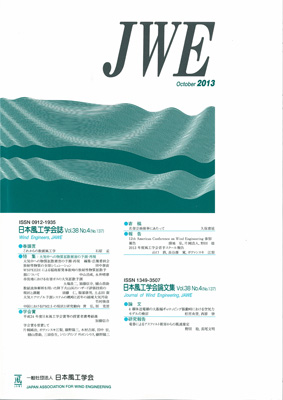All issues

Volume 38, Issue 4
[No. 137]
Displaying 1-2 of 2 articles from this issue
- |<
- <
- 1
- >
- >|
Technical Paper
-
Hisato MATSUMIYA, Takashi NISHIHARAArticle type: Technical Paper
2013Volume 38Issue 4 Pages 87-100
Published: October 31, 2013
Released on J-STAGE: December 27, 2013
JOURNAL FREE ACCESSTo evaluate the applicability of an aerodynamic force model based on quasi-steady theory for simulating the galloping of overhead transmission lines subjected to ice and snow accretion, vibration tests were performed in a wind tunnel using a section model of four-bundled conductors. First, galloping with large amplitudes at low frequencies was successfully simulated in a wind tunnel test using the unique support technique proposed here in the vertical, horizontal, and torsional directions, in the same manner as the galloping in actual lines. The aerodynamic force due to torsional velocity can be formulated by considering the quasi-steady aerodynamic forces acting on the sub-conductor, while it is not included in the quasi-steady aerodynamic force formulated for the entire four-bundled conductor. Time history analysis considering the aerodynamic force caused by torsional velocity agrees well with the test results.View full abstractDownload PDF (2388K)
Technical Report
-
Minoru NODA, Fumiaki NAGAOArticle type: Technical Report
2013Volume 38Issue 4 Pages 101-108
Published: October 31, 2013
Released on J-STAGE: December 27, 2013
JOURNAL FREE ACCESSA road paved with asphalt was damaged by a tornado at Mashiko town in Tochigi prefecture on May 6, 2012. The asphalt with a size of 4m width, 30m length and 50mm thick was peeled off and scattered. Fujita-scale of this tornado was determined from F1 to F2 by Japan Meteorological Agency. If the evaluation is correct, then a lot of damage like this should have been observed more in the past. However, no example that a normal road was damaged by a tornado like this has been observed in Japan. In this paper, the wind speed was estimated from this damage by considering the flying debris and the pressure drop by a tornado. As the result of this estimation, it was clarified that the wind speed reached to 100m/s.View full abstractDownload PDF (2075K)
- |<
- <
- 1
- >
- >|